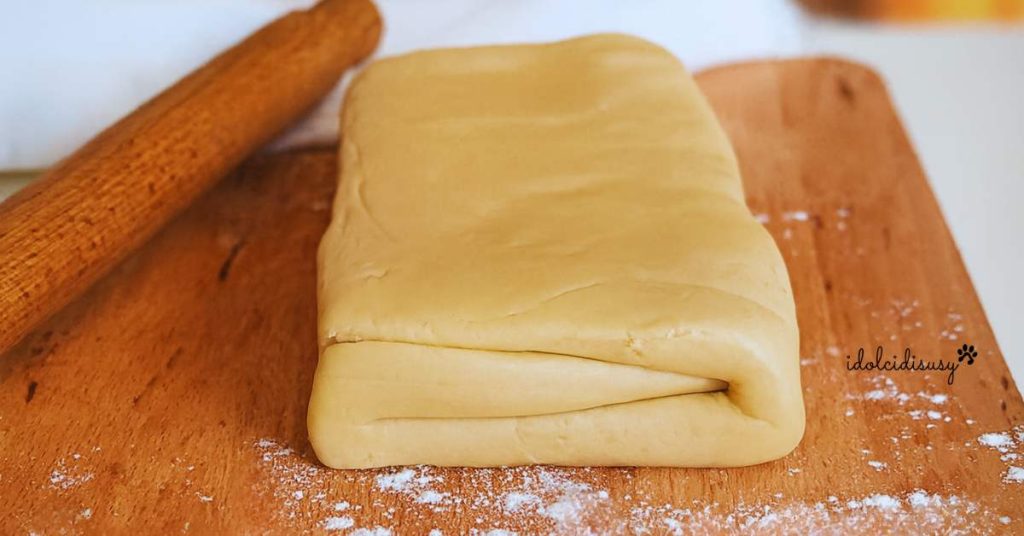Puff pastry is one of the essentials that can’t be missing in the kitchen. After shortcrust pastry (which I always make thinking of my Aunt Franca ❤️), it’s the dough I love the most.
It’s neutral and versatile: perfect for desserts like millefeuille and cannoli, but also for savory pies and snacks. Just a few ingredients — flour, butter, and water — are needed to create the block and the paste, which, with the right folds, lead to a flaky result.
In the oven, the butter releases steam, the dough rises, and thin, crunchy layers that melt in the mouth are formed.
Making it requires a bit of patience, but the satisfaction of making it at home is unique: tastier, more genuine, and more fragrant than the ready-made kind. With puff pastry, you can really get creative!
You might be interested in:

- Difficulty: Medium
- Cost: Very Cheap
- Rest time: 1 Hour 30 Minutes
- Preparation time: 1 Hour
- Portions: 6
- Cooking methods: No Cooking
- Cuisine: Italian
- Energy 457.08 (Kcal)
- Carbohydrates 28.58 (g) of which sugars 1.08 (g)
- Proteins 5.96 (g)
- Fat 35.25 (g) of which saturated 22.58 (g)of which unsaturated 12.25 (g)
- Fibers 0.92 (g)
- Sodium 3.98 (mg)
Indicative values for a portion of 100 g processed in an automated way starting from the nutritional information available on the CREA* and FoodData Central** databases. It is not food and / or nutritional advice.
* CREATES Food and Nutrition Research Center: https://www.crea.gov.it/alimenti-e-nutrizione https://www.alimentinutrizione.it ** U.S. Department of Agriculture, Agricultural Research Service. FoodData Central, 2019. https://fdc.nal.usda.gov
Ingredients for Puff Pastry
- 2 cups Manitoba flour
- 2/3 cup water (cold)
- 2 1/4 cups butter
Tools
- Parchment paper
How to Make Puff Pastry
Place the Manitoba flour on a work surface and form a well. Pour 160 g of cold water into the center and start mixing with a fork or hands, gradually incorporating the flour from the edges. Continue until you get a homogeneous and compact dough: the paste.
Shape it into a ball and cut a cross on the surface, so during the rest it relaxes better. Wrap it in plastic wrap and let it rest in the refrigerator for 30 minutes: this way it stays soft and elastic, ready to be rolled out without difficulty.Take the butter and place it between two sheets of parchment paper. With the rolling pin, beat and flatten it until you get a rectangle about 1/2 inch thick. The butter should be plastic and malleable, but not too soft. If it tends to melt, put it in the refrigerator for a few minutes to return it to the right consistency.
Take the paste out of the fridge and roll it out with the rolling pin on a lightly floured surface until it forms a rectangle (or rhombus) of about 12 inches. Place the butter block in the center and close the edges of the dough like an envelope: first the sides, then top and bottom, so the butter remains well sealed.
Gently roll out the dough into a rectangle about 12 inches long. Make the first three-fold: bring the top third towards the center and fold the bottom third over the center, like a book. Rotate the dough 90°, wrap it in plastic wrap, and put it in the fridge for 30 minutes. This rest helps solidify the butter and relax the dough.
Repeat the same fold and fridge rest two more times, for a total of 3 folds. Each time let the dough rest in the fridge for at least 30 minutes. Thanks to this process, you get the thin layers that make puff pastry flaky and crunchy.
After the last fold, leave the puff pastry in the fridge for at least 1 hour, or until ready to use. This way, the dough stabilizes and is ready for all sweet or savory recipes.
Storage and Tips
Homemade puff pastry can be stored in the refrigerator, well wrapped in plastic wrap, for 4–5 days. You can also freeze it already portioned: this way it will always be ready to use. To use it, just transfer it from the freezer to the fridge the night before
For perfect puff pastry, always work in a cool environment and keep both the paste and the butter block very cold. This way the dough doesn’t get damaged and the butter doesn’t melt too much. With a bit of practice, it will become one of the most versatile doughs in your kitchen, ready to use on a thousand occasions, sweet or savory.
For perfect puff pastry, always work in a cool environment and keep both the paste and the butter block very cold. This way the dough doesn’t get damaged and the butter doesn’t melt too much. With a bit of practice, it will become one of the most versatile doughs in your kitchen, ready to use on a thousand occasions, sweet or savory.
Frequently Asked Questions
Why doesn’t puff pastry rise?
It usually happens if the butter wasn’t cold enough or if the folds weren’t done correctly. Also, the oven temperature must be high and consistent.
Can you make puff pastry without Manitoba flour?
Yes, you can use a medium strength all-purpose flour, but Manitoba helps give more elasticity and strength to the dough.
Can I use margarine instead of butter?
It’s possible, but the result will be less fragrant and tasty. With butter, the pastry is definitely better.
Can you freeze homemade puff pastry?
Yes, you can freeze it already divided into portions. When needed, just defrost it slowly in the fridge overnight.
How many folds are needed for perfect puff pastry?
Usually, 3 three-folds with rests in the fridge are sufficient to obtain a thin, crunchy, and well-layered pastry.

